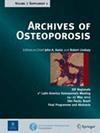The impact of biological age and age acceleration on 1-year mortality rates in elderly hip fracture patients: a prospective cohort study
IF 2.8
3区 医学
Q2 ENDOCRINOLOGY & METABOLISM
引用次数: 0
生物学年龄和年龄加速对老年髋部骨折患者1年死亡率的影响:一项前瞻性队列研究
本研究探讨了从常规实验室测试计算的生物年龄如何比实足年龄更好地预测老年髋部骨折患者的1年死亡率。我们的研究结果强调了生物老化的增加与更高的死亡率有关,强调了其改善术前风险评估的潜力。老年髋部骨折导致高发病率和高达30%的1年死亡率。将生物学年龄和年龄加速纳入传统的评估可以改善预后预测,指导临床干预和围手术期咨询。方法:在这项前瞻性研究中,年龄≥50岁的低能量髋部骨折患者术前收集了人口统计学资料、实足年龄、合并症和9个实验室参数。根据Levine等人(2018)计算生物年龄,年龄加速被定义为生物年龄和实足年龄之间的差异。结果:纳入91例患者。平均实足年龄76.6岁(SD 9.2),生理年龄90.5岁(SD 15.0),年龄加速13.9岁(SD 13.1);平均Charlson合并症指数为4.1 (SD 3.1)。一年死亡率为25.3%。死亡组的CCI较高(6.0 vs. 3.5;P = 0.001),生物年龄(102.6 vs 86.4;结论:生物学年龄和年龄加速在预测1年死亡率方面优于实足年龄,支持它们在老年髋部骨折患者风险分层中的作用。
本文章由计算机程序翻译,如有差异,请以英文原文为准。
求助全文
约1分钟内获得全文
求助全文
来源期刊

Archives of Osteoporosis
ENDOCRINOLOGY & METABOLISMORTHOPEDICS -ORTHOPEDICS
CiteScore
5.50
自引率
10.00%
发文量
133
期刊介绍:
Archives of Osteoporosis is an international multidisciplinary journal which is a joint initiative of the International Osteoporosis Foundation and the National Osteoporosis Foundation of the USA. The journal will highlight the specificities of different regions around the world concerning epidemiology, reference values for bone density and bone metabolism, as well as clinical aspects of osteoporosis and other bone diseases.
 求助内容:
求助内容: 应助结果提醒方式:
应助结果提醒方式:


